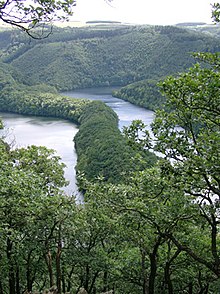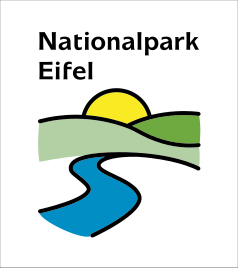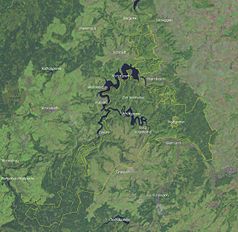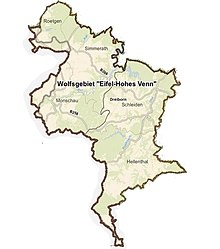Eifel National Park
| Eifel National Park | ||
|---|---|---|
|
|
||
| Location: | North Rhine-Westphalia , Germany | |
| Next city: | Monschau , Schleiden , Mechernich , Düren , Aachen | |
| Surface: | 10,700 ha | |
| Founding: | January 1, 2004 | |
| Address: |
www.nationalpark-eifel.de Eifel National Park Forestry Office Urftseestraße 34 D – 53937 Schleiden-Gemünd |
|
| The area of the national park | ||
The Eifel National Park is the 14th national park in Germany and the first in North Rhine-Westphalia , in the middle of the Hohes Venn-Eifel nature park . It was established on January 1, 2004. It covers an area of 10,770 hectares, over 3000 hectares of which are part of the Dreiborn plateau (former Vogelsang military training area ).
General


The technical objectives of the IUCN apply to the Eifel National Park . Accordingly, at least 75 percent of the national park area will be left to nature without human use within 30 years of the park's establishment. Framework goals, instruments and organs are set out in the National Park Ordinance (NP-VO). The relatively young national park is located in the north of the Eifel between Nideggen in the north, Gemünd in the south and the Belgian border in the southwest. Since January 1, 2004, the state's statutory order has been in force, which lays the foundation for the park. The national park administration was transferred to the National Park Forestry Office Eifel based in Schleiden. Henning Walter was appointed head of the forestry office and thus the first head of the national park administration .
The area is about 10,770 hectares , borders the Rurstausee in the northwest and includes the Urfttalsperre and the former Vogelsang military training area , but not the former Nazi Ordensburg Vogelsang . The area of the Vogelsang military training area on the Dreiborn plateau , which was formerly administered and used by the Belgian military , makes up around 3,300 hectares of the total area and has only been open to the public since January 1, 2006.
The Eifel National Park protects the Hainsimsen - beech forest, which is characterized by the Atlantic climate and which has been preserved in parts of the northern Eifel and originally covered the entire Eifel and large parts of Central Europe. Deciduous and coniferous forests, lakes, streams and open grassy areas extend over 110 square kilometers. A large, uncut forest area with a high proportion of beech forest is the Kermeter , within which the Schäferheld and Wiegelskammer natural forest cells are located. This forest area is accessible on hiking trails, some of which are barrier-free.
Forest in the national park
Due to the former types of use of the forest, in particular the extraction of charcoal , large areas in the Eifel were still free from forests at the beginning of the 19th century. Only the Prussians planted large parts of the Eifel with spruce in the 19th century. This tree species was further promoted after the Second World War . Spruces grow faster than many deciduous tree species and thus enable faster reforestation . As nature is largely left to its own devices after being designated as a national park, many conifers can fall victim to the bark beetle . The Kermeter ridge, which is bordered by the Rurtalsperre to the north and west and the Urfttalsperre to the south , is particularly affected, as the bark beetles enjoy the relatively low-precipitation climate there. This is a natural process, but it is supervised. Spreading to coniferous forest areas outside the national park should be prevented in good time.
When it was designated in 2004, the forest took up around 8,190 ha or 75% of the national park area. Before the designation, the state of North Rhine-Westphalia acquired 1,300 hectares of private forest area in 2003, so that no private forest areas were available when the national park was designated. In 2004, 40% of the forest was planted with spruce, 22% with oak, 16% with beech, 9% with pine, 6% with other forests, 4% with other deciduous forests and 3% with Douglas fir. With the designation, 4,122 hectares or 38% of the area were placed under process protection. Process protection means that all use has been stopped in order to enable the forest to develop undisturbed. Only natural regeneration of non-native tree species such as the spruce was removed, with the biomass or trees remaining on the areas. By 2034 at the latest, a further 4,030 hectares or 37% of the forest area should be given over to process protection. After 2034, a further 1,310 hectares of forest are to be left to process protection. The forest is supposed to take up 9,462 hectares or 87% of the area of the park. Between 2004 and 2014, 250 hectares of spruce were removed. 156 hectares of spruce forest were removed over an area of 26 km along streams. Extensive spruce harvesting was also carried out on waterlogged soils. The resulting open spaces were left for natural reforestation. Emerging spruce natural regeneration was removed again. Between 2004 and 2014, 600 hectares of spruce forest were underplanted with beeches of local origin in a buffer strip at the borders of the park. Another 200 hectares of spruce should be underplanted with beeches from 2014. The beech grows well in the shade and can also grow in spruce forests. However, a few more decades will pass before the beech is again the dominant tree species in these forest areas. Since 2004, 274 hectares of forest were with Douglas fir and partially admixed tree species grand fir and hemlock away or on some surfaces curled to bring the trees to die. In some cases, the Douglas fir remained as lying or, in the case of ringed trees, as standing deadwood . Alien Weymouth pines and red oaks in the area were also ringed. The natural regeneration of all non-European tree species is actively combated. During hurricane Kyrill on 18./19. In January 2007, 63 hectares of spruce forest were overturned. 30 hectares of these spruce areas were left untreated to develop naturally. 700 hectares of spruce forest have been left to process protection and dynamic development. In stands of Scots pine with 720 ha, no measures were carried out, since the natural regeneration of Scots pine is not a relevant competition for native tree species.
Biodiversity in the national park
There are currently 10,549 species recorded in the Eifel National Park. 2,405 of these species have an endangered status according to the Red Lists of North Rhine-Westphalia and Germany. With a share of 50%, the 1,336 insect species are by far the most species-rich group. There are 2,098 species of beetle among the insects and 1,379 species of butterflies, including 1,272 species of night butterflies. Other important groups of insects are the two-winged species with 499 species, hymenoptera with 435 species, cicadas with 275 species, bugs with 268 species and caddis flies with 118 species. 1,949 species of fungi were detected. Spiders are represented with 310 species and vertebrates with 251 species. 100 species of snails and mussels were found. Fern and flowering plants have 900 species. There are also 768 species of algae (including cyanobacteria), 368 species of moss, 358 species of lichen and 371 other species. The development of species diversity is documented by monitoring.
For the years 2015 to 2017, two projections calculated 1121 or 1276 red deer for the national park , with a fluctuation range of ± 84 animals and ± 83 animals, respectively.
Star park, star region
In February 2014, the National Park received preliminary recognition as a "Star Park" by the International Dark Sky Association because it still gets really dark here at night and you can see the stars clearly. It was also important to protect nature from the stress of artificial light, especially its particularly harmful blue component. On April 5, 2019, the national park was finally designated as the "International Star Park Eifel National Park". The next higher goal that the national park region has set itself is recognition as a star region . A condition for this is that suitable measures against waste of light and incorrect use are carried out within a radius of 15 km from the national park. Raising awareness among the population has already begun, so that this title is quite achievable.
Path system
Around 240 kilometers of hiking trails are open to visitors in the Eifel National Park. Cyclists are allowed to use 104 kilometers and riders 65 kilometers. If there is enough snow, two cross-country trails, each five kilometers in length, are groomed in the south of the national park. All paths are marked with wooden signs and entered in the current hiking map of the Eifelverein .
Several hiking trails are signposted throughout the national park. The circular hiking trails "Theme tours" and the four-day "Wilderness Trail" are specially geared towards the protected area and supported by relevant literature.
In 2016, the North Eifel Nature Park set up trekking sites in the Eifel National Park region with space for up to two tents (for a fee). These places can only be reached on foot. The “Nordstern” natural camp site is located in the area of the former NS “Ordensburg” Vogelsang outside the national park area.
The wilderness trail
In four demanding daily stages, visitors can cross the entire national park with its various landscapes. The 85-kilometer wilderness trail is laid out in such a way that it leads from Monschau-Höfen in the southwest in many turns to the northernmost tip of the protected area in Hürtgenwald- Zerkall . Fallen trees, giant old trees and growing sprouts give in some sections a first impression of what it will look like almost everywhere in a few decades.
National Park Center with the adventure exhibition "Wilderness Dreams"
In the middle of the Eifel National Park - with a panoramic view of the Urftsee - at the Vogelsang International Square is the Eifel National Park Center with the adventure exhibition "Wilderness Dreams". The barrier-free and multilingual exhibition offers a variety of sensory experiences and invites you to learn more about the national park concept and the dynamics of nature. Special events, guided tours with a national park ranger and programs that can be booked complete the offer. from. The exhibition "Wilderness Dreams" is open daily from 10 a.m. to 5 p.m. (Christmas Eve and New Year's Eve until 2 p.m.).
National park gates
To welcome visitors and to provide information in the tourist service area, the respective cities or municipalities have set up five national park gates together with the Eifel National Park Administration. With free admission, they are open daily from 9 a.m. to 5 p.m. from April to October and from 10 a.m. to 4 p.m. from November to March. In addition to the basic information, each information center offers a different focus topic in the form of a small national park exhibition.
In the Rurberg National Park Gate on Eiserbachdamm, the motto is the lifelines of nature , where water is the main theme of the permanent exhibition. In Gemünd , visitors learn exciting forest stories in the national park gate at the spa gardens. In Heimbach , in the old station building, forest secrets are the focus of a walk-in radio play. The narcissus meadows are a main theme in the Höfen National Park Gate . The largest occurrence of the yellow wild daffodil in Germany begins on the edge of the "Federal Gold Village". In Nideggen it comes to people and nature, while rotating among other things, the logistics of nature. In particular, the national park gates in Höfen and in Nideggen are also suitable for people with disabilities thanks to guidance systems, audio equipment that can be borrowed, etc. Barrier-free sanitary facilities are available in all five gates.
guides
The national park offers regular, free tours with a trained ranger . Visitors can choose between at least eight offers per week with different requirements. Registration is not required. The rangers not only tell informative things on the way, but also share nice anecdotes and their own experiences. All circular hikes are also suitable for blind and visually impaired people with an accompanying person as well as for families with children. Every fourth Saturday of the month, the Tangiers offer special guided tours that are thematically adapted to the season.
In addition to these ranger tours, there are guided tours with trained forest guides, multilingual tours, hikes with sign language accompaniment, ranger boat trips, carriage rides and more on irregular dates or depending on the season. The monthly family days, which also take place on Tuesdays and Thursdays during the school holidays in North Rhine-Westphalia, are specially geared towards children and parents. Information about these offers and the forest guides that can be booked for individual groups is available from the Eifel National Park Forestry Office.
Danger from old military contamination
Large parts of the former military training area and thus of the national park cannot be opened to the public without restrictions, since a large part of the former military training area Vogelsang is likely to be contaminated with ammunition residues and old loads and a comprehensive and deep clearance would be too costly. The problem is the contaminated sites, which not only stem from the post-war use as a firing range and general camp operations, but also to a large extent to ammunition remains from the bombardment in the Second World War (duds). During the Second World War, glass mines were laid near the dam wall of the Urfttalsperre , which even today cannot be cleared. Known areas, possibly still contaminated with ammunition residues, are cordoned off with fences; Entering off the official routes is - as in the entire national park - strictly forbidden.
Criticism of the concept
The Eifel National Park has been criticized by nature conservationists for years. In February 2008, Volker Hoffmann, the spiritual father of the national park, resigned as chairman of the national park's friends' association and also resigned from his position as a representative of the BUND in the national park committees. He thus protested u. a. against too great concessions to commerce and tourism. He also complained about the logging by the National Park Forest Office. Two years later, Wilhelm Bode attacked the National Park Forest Office sharply in his Bürgerwald concept, which he had written for the Naturschutzbund Deutschland . He criticized deforestation that was carried out under the pretext of silvicultural conversion. In December 2013, Holger Sticht, NRW state chairman of the BUND , drew a “sobering balance sheet” on the national park's ten-year anniversary: The “birth defect” is that the national park office is not a specialist authority, but a forest office that belongs to the state forest and wood organization in North Rhine-Westphalia . "The goat was turned into a gardener." In January 2014, the ARD magazine Plusminus reported on "clear cutting in the nature reserve" and suspected a connection between long-term wood supply contracts that the state of North Rhine-Westphalia had entered into after Hurricane Kyrill , which however turned out to be False claim turned out to be.
Protected areas in the national park
There were already some nature reserves in the area of today's national park. According to the National Park Administration, the nature reserves continue to exist as legally binding areas. The national park with its regulations of the national park ordinance is superimposed. In terms of content, nature reserve regulations such as protection purposes, goals and requirements / prohibitions do not contradict each other with the specifications of the national park.
Since July 2019, the Eifel around Monschau has been the third region in North Rhine-Westphalia in which a wolf has settled. The “Eifel / Hohes Venn” wolf area designated by the NRW Ministry of the Environment is 505 square kilometers and is located in the Monschau, Hellenthal, Schleiden, Simmerath and Roetgen area.
See also
literature
- Maria Pfeifer: Eifel National Park, Theme Tours Vol. 4, By bike through the Eifel National Park. 1st edition, JP Bachem Verlag 2008, ISBN 978-3-7616-2179-0 .
- Maria Pfeifer: The Wilderness Trail in the Eifel National Park, themed tours vol. 3, four day stages between 18 and 25 km. 1st edition. JP Bachem Verlag 2007, ISBN 978-3-7616-2154-7 .
- Maria Pfeifer: Short hikes in the Eifel National Park, themed tours vol. 2, 12 easy tours between 2 and 7 km. 2nd Edition. JP Bachem Verlag 2007, ISBN 978-3-7616-2010-6 .
- NRW Foundation / Eifelverein (publisher): Eifel National Park, Themed Tours Vol. 1, 10 tours between 5 and 18 km. 4th completely revised edition. JP Bachem Verlag 2007, ISBN 978-3-7616-2068-7 .
- Ulrike Schwieren-Höger: Eifel National Park. The adventure guide for the entire region , 2nd revised and expanded edition. Eifel-Verlag, Cologne 2012, ISBN 978-3-943123-04-3 .
- NUA seminar reports: Eifel National Park - An idea takes shape ( Memento from June 28, 2006 in the Internet Archive ). NUA seminar report Volume 8. 5th year. Recklinghausen 2002.
- Landesbetrieb Wald und Holz (Ed.): National Park Plan of the Eifel National Park, Volume 1: Mission statement and goals . Schleiden-Gemünd 2008.
- Friends of the Eifel National Park (ed.): Flora and fauna in the Eifel National Park . JP Bachem Verlag, Cologne 2006, ISBN 3-7616-2005-5 .
- Friends of the Eifel National Park (ed.): Mosses and lichens in the Eifel National Park . JP Bachem Verlag, Cologne 2007, ISBN 978-3-7616-2153-0 .
- Eifelverein (ed.): National park map, 1: 25,000, hiking, cycling, riding, hiking map No. 50 of the Eifelverein . 2008, ISBN 978-3-921805-51-0 .
Web links
- Homepage of the national park
- Homepage of the National Park Association
- Information portal about the history of the former "NS-Ordensburg" Vogelsang in the middle of the Eifel National Park ( Memento from February 2, 2009 in the Internet Archive ) (private website, closed)
- Literature from and about the Eifel National Park Forestry Office in the catalog of the German National Library
- Literature from and about the Eifel National Park Association in the catalog of the German National Library
- Leaflet "At a glance" with a map
Individual evidence
- ↑ Ordinance on the Eifel National Park. (PDF) The Minister for the Environment and Nature Conservation, Agriculture and Consumer Protection of the State of North Rhine-Westphalia, accessed on May 3, 2019 .
- ↑ Barrier-free nature experience Wilder Kermeter and Wilder Weg - nationalpark-eifel.de , accessed on July 25, 2015
- ↑ Eifel National Park: After the curling, they are red. In: Kölner Stadt-Anzeiger . August 12, 2011, accessed August 11, 2015 .
- ↑ Michael Röös, Julian Mauerhof: Eifel National Park. Active forest development in spruce and Douglas fir. Nature in NRW 4/2014, pp. 11–15
- ↑ Andreas Pardey, Sönke Twietmeyer: Species diversity in the Eifel National Park. Nature in NRW 3/2018, pp. 11–15.
- ↑ Martin Müller, Michael Petrak, Florian Krumpen, Michael Röös: Rothirsch - route recalculation for the Eifel National Park. Nature in NRW 1/2020, pp. 38–41.
- ↑ a b Star region Eifel National Park, our goal
- ↑ Eifel National Park becomes a Star Park . In: world . April 5, 2019 ( welt.de [accessed April 5, 2019]).
- ↑ Leandra Kubiak: Northern Eifel should become a “star region”. In: Aachener Zeitung. November 18, 2014, accessed November 18, 2014 .
- ↑ Nordstern nature camp. In: EifelPfadFinder. Outdooractive, accessed on June 13, 2016 (source: Eifelverein).
- ↑ Trekking in the Eifel. North Eifel Nature Park V., accessed on June 13, 2016 .
- ↑ Eifel National Park Center | Eifel National Park. Retrieved July 21, 2020 .
- ↑ The initiator of the National Park feels betrayed. ( Memento from February 22, 2014 in the Internet Archive ) Aachener Zeitung, February 7, 2008, p. 5.
- ^ Wilhelm Bode: The NRW Bürgerwald concept. (PDF) May 2010, p. 77 , accessed on May 20, 2015 .
- ↑ Eifel National Park a pure tourist park? BUND draws a "sobering balance" after 10 years of the Eifel National Park. December 12, 2013, accessed April 26, 2014 .
- ↑ Clear cutting in the nature reserve - Plusminus broadcast from April 2, 2014 ( Memento from October 12, 2014 in the Internet Archive )
- ^ [1] Third wolf area for NRW
- ↑ [2] Wolf area and buffer zone








